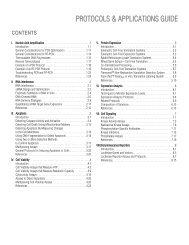2012 Promega catalogue
2012 Promega catalogue
2012 Promega catalogue
Create successful ePaper yourself
Turn your PDF publications into a flip-book with our unique Google optimized e-Paper software.
Cell Signaling<br />
Streptavidin<br />
Product Size Cat.# Price ($)<br />
Streptavidin 1 mg Z7041 88.00<br />
For Laboratory Use.<br />
For additional information see page 10.<br />
Streptavidin Alkaline Phosphatase<br />
Product Size Cat.# Price ($)<br />
Streptavidin Alkaline Phosphatase 0.5 ml V5591 250.00<br />
For Laboratory Use.<br />
For additional information see page 10.<br />
Protein Interactions<br />
CheckMate/Flexi ® Vector Mammalian Two-<br />
Hybrid System<br />
Product Size Cat.# Price ($)<br />
CheckMate/Flexi ® Vector Mammalian Two-Hybrid<br />
System 1 each C9360 975.00<br />
Available Separately<br />
pFN10A (ACT) Flexi ® Vector 20 µg C9331 489.00<br />
pFN11A (BIND) Flexi ® Vector 20 µg C9341 489.00<br />
pGL4.31[luc2P/GAL4UAS/Hygro] Vector 20 µg C9351 567.00<br />
CheckMate Positive Control Vectors 1 set C9370 335.00<br />
CheckMate Negative Control Vectors 1 set C9380 224.00<br />
For Research Use Only. Not for Use in Diagnostic Procedures.<br />
Description: The CheckMate/Flexi ® Vector Mammalian Two-Hybrid<br />
System provides a means to confirm, validate and study suspected interactions<br />
between two proteins or domains and can also be used to generate stable<br />
cell lines for cell-based assays. Developed primarily for mammalian proteins<br />
of interest, the system can allow protein expression and post-translational<br />
modifications in an environment mimicking the native cell milieu. It is patterned<br />
on the yeast two-hybrid system with one protein of interest (“X”) fused to a<br />
DNA-binding domain and the other protein (“Y”) fused to a transcriptional<br />
activation domain.<br />
The system relies upon three plasmids that are co-transfected into<br />
mammalian cells, each plasmid having unique features. The pFN10A (ACT)<br />
Flexi ® Vector contains a herpes simplex virus VP16 transcriptional activation<br />
domain upstream of the cloning site, and the pFN11A (BIND) Flexi ® Vector<br />
contains the yeast GAL4DNA-binding domain upstream of the cloning site. The<br />
pFN11A (BIND) Flexi ® Vector also expresses the Renilla reniformis luciferase<br />
under the control of the SV40 promoter, allowing normalization for differences<br />
in transfection efficiency. The third vector, pGL4.31[luc2P/GAL4UAS/Hygro]<br />
Vector, contains five GAL4 binding sites upstream of a minimal TATA box, which<br />
is upstream of a firefly luciferase gene that acts as a reporter for interactions<br />
between proteins X and Y.<br />
This system differs from the original CheckMate Mammalian Two-Hybrid<br />
System in that the vectors are compatible with the Flexi ® Vector System, which<br />
allows directional cloning and rapid, efficient and high-fidelity transfer of protein<br />
coding regions between a variety of Flexi ® Vectors.<br />
For complete and up-to-date product information visit: www.promega.com/catalog<br />
Features:<br />
• Mammalian-Based System: Interactions can be studied in the cell<br />
line of choice. Proteins are more likely to be in their native conformation.<br />
Post-translational modifications, such as glycosylation, phosphorylation and<br />
acylation, are better maintained.<br />
• Versatile: Vectors are based on the Flexi ® Cloning technology, enabling<br />
convenient transfer of protein-coding regions for additional functional<br />
proteomics applications.<br />
• Convenient: The Dual-Luciferase ® Reporter Assay System is used for<br />
detection.<br />
Storage Conditions: Store at –20°C.<br />
Protocol Part#<br />
CheckMate/Flexi ® Vector Mammalian Two-Hybrid System<br />
Technical Manual<br />
TM283<br />
CheckMate Mammalian Two-Hybrid<br />
System<br />
Product Size Cat.# Price ($)<br />
CheckMate Mammalian Two-Hybrid System 1 system E2440 998.00<br />
For Research Use Only. Not for Use in Diagnostic Procedures.<br />
Description: Two-hybrid systems are extremely powerful methods for<br />
detecting protein:protein interactions in vivo. The basis of two-hybrid systems<br />
is the modular domains found in some transcription factors: a DNA-binding<br />
domain, which binds to a specific DNA sequence, and a transcriptional<br />
activation domain, which interacts with the basal transcriptional machinery. A<br />
transcriptional activation domain in association with a DNA-binding domain will<br />
promote the assembly of RNA polymerase II complexes at the TATA box and<br />
increase transcription. In the CheckMate Mammalian Two-Hybrid System<br />
the DNA-binding domain and the transcriptional activation domain, produced<br />
by separate plasmids, are closely associated when one protein (“X”) fused<br />
to a DNA-binding domain interacts with a second protein (“Y”) fused to a<br />
transcriptional activation domain. In this system, interaction between proteins X<br />
and Y results in transcription of a reporter gene.<br />
Features:<br />
• Mammalian System: Interactions can be studied in the cell line of choice.<br />
Proteins are more likely to be in their native conformation. Post-translational<br />
modifications, such as glycosylation, phosphorylation and acylation, are<br />
better maintained.<br />
• Convenient Quantitation: The Dual-Luciferase ® Reporter Assay System<br />
is used for detection.<br />
• Internal Control: Renilla luciferase normalizes transfection efficiency.<br />
• Fast Transient Assay: Results obtained two days after transfection, as<br />
compared to 3–4 days with the yeast system.<br />
• Stable Transfectants: The pACT Vector contains the neomycin<br />
phosphotransferase gene, which allows for selection of stable transfectants.<br />
Storage Conditions: Store at –20°C.<br />
Protocol Part#<br />
CheckMate Mammalian Two-Hybrid System Technical Manual TM049<br />
253<br />
14<br />
Protein Purification and Interactions<br />
Section<br />
Contents<br />
Table of<br />
Contents
















